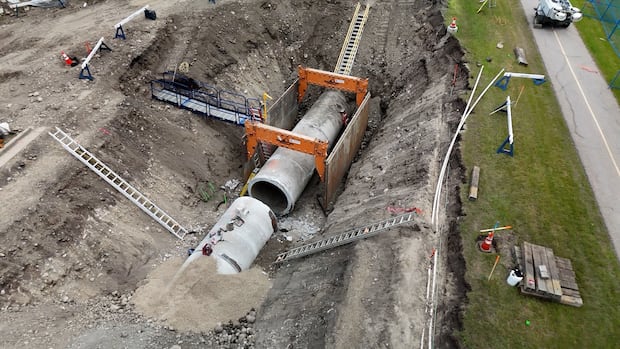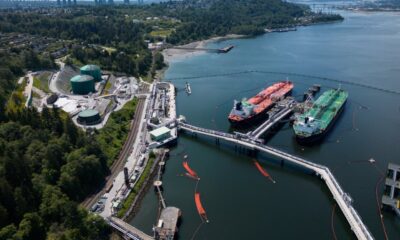Top Stories
Calgary Maintains Road Salt Use Despite Water Main Break Risks

UPDATE: Calgary continues to apply sodium chloride on its roads, even after it was linked to a catastrophic water main break last year. Following a recent snowfall, the city’s reliance on road salt raises urgent questions about infrastructure safety and environmental impact.
In June 2024, Calgary declared a local state of emergency after the Bearspaw south feeder main ruptured, causing significant water restrictions. An official report from Associated Engineering identified multiple contributing factors, including high chloride levels in soil, microcracking in protective mortar, and snapped wires from corrosion. Notably, it stated, “Elevated soil chloride concentrations are believed to be related to road de-icing activities using sodium chloride.”
Calgary officials, including mobility maintenance manager Chris Hewitt, confirmed that sodium chloride remains the primary choice for winter road maintenance. “At the moment, the most effective product remains sodium chloride, and that really is the standard de-icing material across North America,” he stated. The city uses between 40,000 and 50,000 tonnes of road salt annually.
However, the investigation highlights a troubling trend: a significant increase in chloride levels over the past decade. The report noted a “dramatic shift in chloride concentrations” in soil samples from 2014 to 2024. Concerns about the long-term effects of road salt are mounting, especially with the estimated repair costs for the Bearspaw break soaring to $40 million.
The city’s approach has been met with skepticism. Current city councillor Jennifer Wyness indicated that they are exploring various options for winter road maintenance, including alternative de-icing solutions. “Unfortunately, in the climate we operate in, you do need salt to help get us traction and manage snow at different temperature levels,” she explained.
Despite the environmental and infrastructural concerns, Calgary continues to rely heavily on sodium chloride. Alternatives like beet brine, which has shown promise in reducing corrosion, are being tested but come at a higher cost. “It makes our brine about 75 percent less corrosive than a brine without those additional additives,” said Tim Byrne, maintenance operations manager in Lincoln, Nebraska, where beet brine is used for winter maintenance.
City Councillor Andre Chabot expressed caution regarding the report’s findings, noting that sodium chloride was identified as only one of several potential factors in the water main break. He remains open to alternatives near critical infrastructure but emphasizes the effectiveness of traditional road salt.
Meanwhile, Councillor Dan McLean advocates for more investment in less damaging solutions, stating, “If it’s corrosive and it’s damaging our infrastructure, I don’t care what the cost is.”
As the city grapples with these pressing issues, the investigation into the Bearspaw south feeder main break continues, with an independent review led by former businessman Siegfried Kiefer. The outcome could shape Calgary’s winter road maintenance strategy moving forward.
Residents are left to wonder: will Calgary prioritize immediate safety on the roads over the long-term health of its infrastructure and environment? The stakes are high, and the need for a sustainable solution is becoming increasingly urgent as winter approaches once again.
Stay tuned as we continue to follow this developing story.
-

 Politics3 weeks ago
Politics3 weeks agoSecwepemc First Nation Seeks Aboriginal Title Over Kamloops Area
-

 World4 months ago
World4 months agoScientists Unearth Ancient Antarctic Ice to Unlock Climate Secrets
-

 Entertainment5 months ago
Entertainment5 months agoTrump and McCormick to Announce $70 Billion Energy Investments
-

 Lifestyle4 months ago
Lifestyle4 months agoTransLink Launches Food Truck Program to Boost Revenue in Vancouver
-

 Science5 months ago
Science5 months agoFour Astronauts Return to Earth After International Space Station Mission
-

 Technology3 months ago
Technology3 months agoApple Notes Enhances Functionality with Markdown Support in macOS 26
-

 Top Stories2 months ago
Top Stories2 months agoUrgent Update: Fatal Crash on Highway 99 Claims Life of Pitt Meadows Man
-

 Lifestyle3 months ago
Lifestyle3 months agoManitoba’s Burger Champion Shines Again Amid Dining Innovations
-

 Sports5 months ago
Sports5 months agoSearch Underway for Missing Hunter Amid Hokkaido Bear Emergency
-

 Politics4 months ago
Politics4 months agoUkrainian Tennis Star Elina Svitolina Faces Death Threats Online
-

 Politics4 months ago
Politics4 months agoCarney Engages First Nations Leaders at Development Law Summit
-

 Technology5 months ago
Technology5 months agoFrosthaven Launches Early Access on July 31, 2025




















